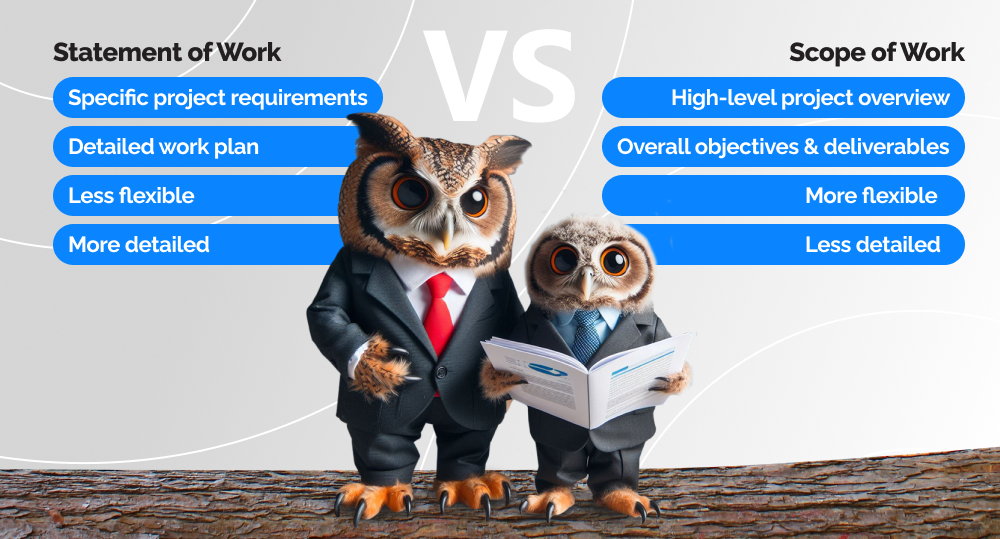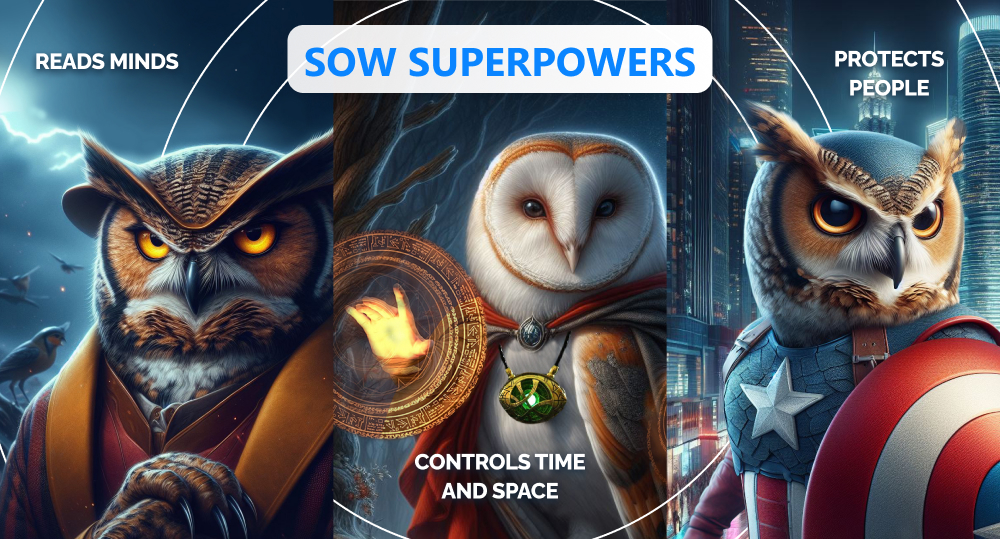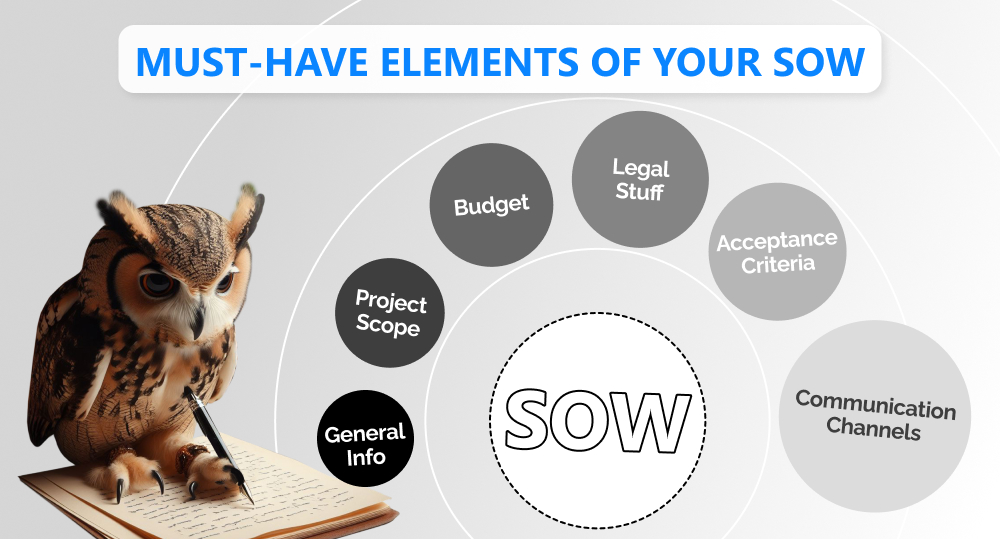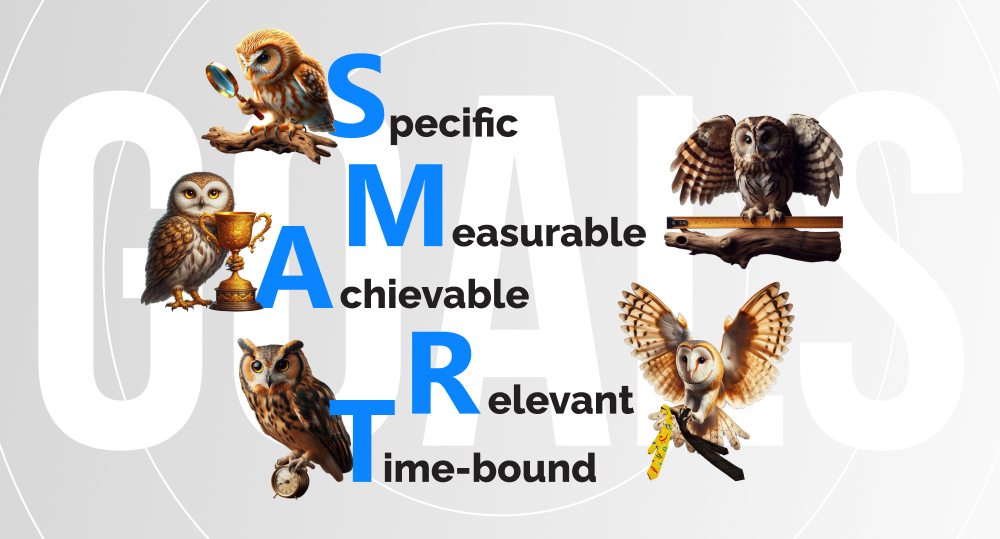Is this your first time creating an SOW for software development? We hope it wasn't a recent failed project that made you take it on. If all your ventures have been a hit, you're a lucky one. After all, 70% of companies worldwide consistently screw up at least one project per year.
But if the statement of work is sort of a clue to win, why aren't the stats getting more positive every year? If you still come across failed entrepreneurs with sad eyes and broken dreams, all their struggles may stem from poor SOW writing skills. In today's blog post, we'll explain how to avoid joining their ranks and compose an effective document that sets you up for success.
written by:
Alexey Krutikov
Project Manager, PMP
Contents
SOW: a Statement of Work or the Strength of Writing?
If you followed the link to this post, you probably know what's behind the SOW abbreviation in software development. But let's take a moment to explore some other concepts that may go unnoticed if you're less familiar with product management.
What Is an SOW in Software Project Management?
The statement of work is an essential PM document that defines the specific tasks, deliverables, and timelines of a project. It serves as a contractual agreement between the company and the service provider, making sure that everyone knows what they're doing.
How else can you decipher the acronym SOW? Our team loves this variant — ‘The Strength of Writing’. In this context, it's more than a communication tool. This document covers your professionalism and ability to plan and organize an efficient workflow.
Statement of Work vs. Scope of Work
Here's an SOW and there's an SOW. Can they be the same? Not really.
The two terms are used in project management, and both are necessary when communicating project details to a software development company. Although the statement of work and the scope of work are closely related, they differ in their focus:
- The statement of work is a legally binding document that provides a detailed and specific overview of the objective and deliverables of software development projects.
- The scope of work in software development is broader, outlining the overall objectives and boundaries of a project. It aids in preventing scope creep and ensures the development process stays on track and within the agreed-upon parameters.
What Powers Can an SOW Document Endow You With?
You won’t argue that creating an SOW is the right move, will you? Among other things, this document will grant you certain superpowers. What are they?
The Power to Read Minds
A statement of work empowers you with the ability to read and control minds — metaphorically speaking, of course. What do we mean? A well-written SOW provides clarity. It ensures that everyone involved in the project has a clear understanding of what needs to be done and when. On top of that, clarity breeds quality, eliminating ambiguity or miscommunication that can lead to costly delays in production.
Not sure if your SOW is “well-written”? In 2012, the Project Management Institute (PMI) developed a process for determining the quality of an SOW. It helps define the relative risk level of a project and suggests areas for improvement before submitting the document to the selected vendor.
The Power to Control Time and Space
“No way!” you'll say, “We're not in a comic book universe.” Here's an explanation. The software development statement of work puts you in control. This business document sets the entire project timeline, milestones, and deadlines. It defines the roles and responsibilities of each team member and imposes clear requirements for their fulfillment. As a result, you can hold people accountable for their actions and make necessary adjustments if things don't go according to plan.
The Power to Protect People
Fans admire comic book superheroes for their ability to defend humanity. Similarly, a software development SOW example guarantees legal protection for both parties involved in the project. Statistically, employees spend 2.1 hours a week on conflicts. This must be exhausting, amounting to the equivalent of 385 million workdays every year in the USA alone! Don't let that staggering figure multiply during your software development project. When you clearly specify the terms of the cooperation, the SOW will prevent potential disputes and shield your rights, without needless yelling.
Must-Have Elements of Your SOW
We are done with the superpowers. Now let's move on to the statement of work for software development and its key components.
General Information about the Project
Start an SOW with a summary of your endeavor, including the project's objectives, purpose, and vision. This will help the software development vendor understand what your idea entails and how you see the result.
Key elements:
- Project name;
- Project background: why we need it, problems, opportunities, and benefits;
- Project objectives;
- Project vision;
- Project purpose.
Detailed Project Scope
After a concise introduction to the essence of the project, you should move on to a detailed description of the scope of work. It specifies the tasks, deliverables, and timelines the software development team must accomplish to finish the project successfully and in alignment with the client's expectations. Be as detailed and direct as possible when defining the scope of work. Clarify the functionality the software developers should build and identify technological limitations and dependencies.
Key elements:
- Functional requirements: specific features, like user authentication, data input forms, reporting capabilities, integration with other systems, coding languages, etc.;
- Non-functional requirements: characteristics, not related to functionality implementation, such as performance, scalability, security regulations, usability, and accessibility;
- Expected deliverables: tangible outputs, like software prototypes, design documents, source code, test cases, user manuals, and other documentation related to your solution;
- Project timeline: specific milestones, delivery dates, and total project duration;
- Exclusions: what is not included in the scope of work. For instance, specific functionality that is not feasible or doesn't meet your goals and constraints.
Precise Budget Allocation
You may skip this part only if you're creating a statement of work example for software development in the future. But for a real SOW, it's a must. No vendor will agree to work on your solution without seeing the price for every hour of their efforts.
When allocating resources, you can follow these steps:
1) Thoroughly analyze the project requirements and identify all the necessary resources: labor, materials, equipment, and other expenses.
2) Prepare a detailed cost breakdown based on the priority and sequence of activities. Some tasks may require a larger portion of the budget upfront due to the estimated effort level, while others may have a phased distribution given their dependencies and timing.
3) Conduct risk assessment and identify uncertainties that may impact your finances: cost overruns, budget constraints, and external factors.
4) Decide on the preferred method, terms, and model for the payment process.
5) Document all the details in your SOW.
Key elements:
- General budget overview;
- Preferred payment terms and schedule;
- Payment model: a dedicated development team, time and material, hybrid, or a fixed-price model.
Effective Communication Channels
Did you know that nearly half of employees report that poor communication negatively impacts their productivity? The SOW is your chance to avoid this pitfall and form a connection with your vendor. By including communication channels in your document, you'll set the stage for effective collaboration, ensuring everyone is in sync.
What channels to choose? While email, the grandfather of digital communication, may suffice for simple updates, more complex discussions involving all parties require a dedicated project management tool. And when it comes to collaborative brainstorming or team bonding, a video conferencing platform can't be beaten.
Popular options
Type
Example
Project management software
Asana, Trello, Jira
Video conferencing services
Zoom, Microsoft Teams, Google Meet
Instant messaging
Slack, Skype for Business, Telegram
In-person meetings
Meeting room, tea room, or any other useful way
Acceptance Criteria
These two words provide a measurable definition of what success looks like for your project or its certain task. The best advice here is to approach the criteria with a positive mindset. Instead of focusing on what can go wrong or what the minimum requirements are, think about what will exceed your expectations and delight both you and the software developer.
Key elements:
- Primary project deliverables or milestones to meet along the way;
- Clear expectations with benchmarks;
- Key performance indicators.
Legal Implications
After drafting the SOW, consult with a law practitioner to ensure the document protects your interests and complies with legal regulations. They can advise on wording, clauses, and other formalities to include in it. Once you and the vendor are satisfied with the SOW, it's time to move forward and sign the final contract. This step formalizes the agreement and provides legal protection to both parties.
Insider Tips for Writing a Virtuous SOW
Here are the finishing touches to help you embrace the power of an SOW and watch your project soar to new heights.
Make Your Goals SMART
You can triumph with your SOW using the time-tested technique of SMART goals. This acronym stands for:
- Specific: clearly define the project's goals.
- Measurable: include concrete deliverables and timelines in the SOW to track progress and evaluate performance.
- Achievable: make sure the scope of work is realistic and attainable.
- Relevant: align the project objectives with your company's broader business goals.
- Time-bound: adjust the milestones and timelines so that the work is completed on time.
Set an Adequate Project Time Frame
We all “love” this word — “deadline”, would you agree? But we should thank deadlines for getting all the work done on time (well, almost all of it). To ensure effective project planning, clearly define the contract's duration, as well as all its major milestones and due dates. Break down complex projects into smaller, less comprehensive tasks and determine estimated timelines for each project phase. This will help create an agile software development SOW template for future reference.
Why do we call the timeline “adequate”? Because you should take into account the engineering team and its efficiency, which inevitably influences the development process. How to ensure success? Consider the following factors when setting a time frame in your software statement of work:
- Project complexity;
- Resource availability;
- Potential risks or contingencies.
Extra tip: it's a wise move to build in some buffer time for unforeseen circcumstances or delays.
Don't Skip the Proofreading Part
Do you have a keen enough eye to spot a typo in the previous paragraph? Your impression of the author changes immediately, doesn't it? Software development companies feel the same way.
Therefore, the final step before sending the SOW to an outsourcing company is to thoroughly proofread it and check for errors or inconsistencies. Grammatical and spelling mistakes undermine the credibility of the writer and the SOW itself.
Let Your Team Fine-Tune the Statement of Work
No one knows better how to teach than a teacher, to code than a coder, and to manage a project than a project manager, agreed?
Remember that communication is key to the SOW writing process. You should regularly discuss the details of the document with the team. Their input and feedback can provide valuable input to the SOW, making it more robust and comprehensive.
Where to seek help:
- Collaborate with subject-matter experts (SMEs);
- Ask stakeholders for feedback;
- Establish a review process with your team members.
Work on a Template
Using a software SOW template can greatly simplify the process of writing this work document. Such templates, acting as a handy roadmap, contain standard sections and wording specific to the SOW. They provide hints and tips to guarantee all necessary information gets a mention.
Extra tip: create multiple templates! Just remember, when working on a project, choose a software SOW example that meets its specific requirements and industry standards.
Bonus: A Ready-to-Use SOW Software Development Template
Any work speeds up if there's a starting point, right? How about a sample SOW for software development? Here you can find and download our free template.
Need a form with autocomplete? Follow this link to get a free template prepared by PandaDoc.
If you’re still unsure about the difference between a scope of work for app development and SOW, hit this link. There you’ll find a sample scope of work for software development.
We Saw a Good SOW. Did You?
Writing an SOW is not only a technical or legal challenge, but also a creative and persuasive one. The goal is to craft a coherent story that showcases the value and distinctive features of your solution. In doing so, you should use concise language that conveys your ideas and product vision. The final document should follow a logical and sequential structure that guides the reader through the project details and requirements.
Sounds exactly like the Hobbit's wanderings through Middle-earth, huh? It only feels like it. The key to a great SOW is your unwavering resolve to dream big and set ambitious goals. Don't settle for mediocrity in your project. Believe in the potential for success, work to achieve it, and try to translate your optimistic mindset to the vendor. With a positive attitude, anything is possible, and you'll be amazed by what you and your team can accomplish.
Need more than a few motivating words, but a trusted software development outsourcing vendor? Contact us, and we'll prove that well-crafted SOWs do their thing.
FAQ
A statement of work is a formal document that defines the scope and details of a project. SOWs are commonly used in project management to outline the work to be done, deliverables, schedule, and other related information. The client or project manager typically creates these documents, and they serve as a contract defining what is expected of both parties.
The SOW is an indispensable component of the process, ensuring that the involved parties have a shared understanding of the project concept and scope. Throughout the development, it serves as a starting point for tracking progress and managing expectations. The SOW typically includes:
- A brief project description;
- Goals and requirements;
- Tasks;
- Deliverables;
- Milestones;
- Legal implications.
The SOW may also specify the roles and responsibilities of the outsourcing team and the customer, as well as any dependencies and constraints that may affect the development process.
Ideally, the responsibility for writing the SOW should fall on a professional with a precise vision of the project requirements and experience in project management and contracting. This can be someone from the PM team, a contract specialist, or a subject-matter expert directly involved in the production. At the same time, the responsible person can and should seek assistance from domain professionals.
Extra tip: create a scope of work example for software development to save hours of work.
It is the process of using technology and software tools to optimize and automate the creation, management, and execution of statements of work. Such SOW management software allows users to create templates, easily customizable for different projects:
- Sample SOW for software development;
- Consulting statement of work template;
- Software development scope of work example;
- Template SOW for library management software;
- Sample statement of work for project management software, etc.

Contacts
Feel free to get in touch with us! Use this contact form for an ASAP response.
Call us at +44 151 528 8015
E-mail us at request@qulix.com










